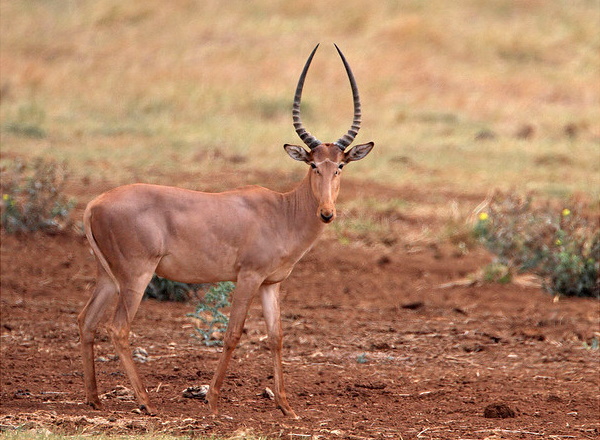Hirola – The Rarest Antelope
The Hirola (Beatragus hunteri) is a Critically Endangered antelope species found in the border regions of Kenya and Somalia. It’s estimated that from 10,000 to 15,000 of these medium-sized tawny antelopes traditionally roamed this area of East Africa. Between 1983 and 1985, however, an outbreak of viral rinderpest reduced the population to roughly 300-500 individuals. The remnant wild Hirola population has not been able to recover from this catastrophe and very few are currently in captivity. (image via Steve Garvie)
* Amazing Antelope Fact: Rinderpest once decimated herds of African mammals, with mortality rates approaching 100%. A vigorous anti-rinderpest campaign conducted in the late 20th century resulted in the last case of rinderpest in the wild by 2001 and an official declaration of its eradication in June of 2011.
Chiru – The Highest Antelope
The Tibetan Antelope (Pantholops hodgsonii), more commonly known as the “Chiru”, ranges across the Tibetan Plateau at altitudes of between 10,660 ft and 18,040 ft (3,250 and 5,500 m). The Chiru has evolved some unique adaptations that allow it to thrive in the rarefied air. Chief among these is the retention of the fetal version of hemoglobin throughout its lifetime, allowing these antelopes to maintain a higher concentration of oxygen in their blood. (image via YONGZHONG LIU)
* Amazing Antelope Fact: The fur of the Chiru has traditionally been used to produce luxurious Shahtoosh shawls, prized for their softness and presented as wedding gifts. Unlike wool sheared from sheep, however, the fur cannot be harvested from living animals. Since the late 1990s, the Chinese government has instituted a variety of measures to discourage poaching and protect wild Chiru.
Addax – The Hottest Antelope
The Addax (Addax nasomaculatus) is recognized as the most desert-adapted antelope. Also known as the “White Antelope” and the “Screwhorn Antelope”, the Addax is found in isolated desert and semi-desert regions of the southern Sahara Desert. Once common throughout North Africa and the Levant, the Addax has become one of the rarest antelopes: only about 600 exist in the wild while a similar number reside in captive environments such as zoos, farms and sanctuaries. (image via Richard Allen)
* Amazing Antelope Fact: To survive high heat, lack of water sources and punishing desert conditions, Addax’s are active by night and sleep or rest during daylight hours. Their hooves are broad and flat – the better to walk on shifting sands. Their pale coats reflect the heat of the sun while their stomachs are lined with pouches that hold water in times of scarcity.
Gerenuk – The “Neckst” Antelope
The Gerenuk (Litocranius walleri) looks a lot like many medium-sized antelope species with one big exception: their startlingly long necks! This salient feature has given rise to one of the Gerenuk’s colloquial names – the Giraffe Gazelle. Native to parts of parts of East Africa, Gerenuks can grow up to 5 ft (160 cm) long. Their long and sinuous necks, however, allow them to stand on their hind legs and reach leafy tree branches almost 7 ft (2 m) above the ground. (image via Brad)
* Amazing Antelope Fact: Only male Gerenuk have horns, which can grow up to 17.5 inches (44 cm) long). As with all antelopes, the horns have bony cores and are covered with a hard sheath of keratin – they are not shed like deer or reindeer antlers, and if broken they cannot be regrown.
Could ruminants roaming around the yard really be so baaad? Check out No Kidding: Goat Yoga Is Happening!

